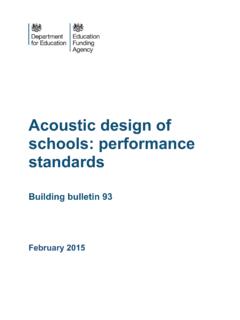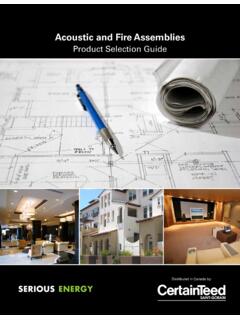Transcription of ACOUSTIC PROBLEMS & SOLUTIONS - Wenger Corp
1 ACOUSTIC PROBLEMS & SOLUTIONSFOR REHEARSAL AND PRACTICE OF CONTENTS2 SOUND ISOLATIONHere we provide some basic tipsfor identifying how unwanted soundsare leaking into your music areasand how your music may be disturbing classrooms or officeareas nearby. We explain what canbe done with doors, windowswalls, floors, ceilings and ventilationducts that are often at the root ofthese ROOM ACOUSTICSThis section addresses problemssuch as excessively loud rooms,boominess, dead spots, echoesand more. It explains how roomsize, shape and surface materialsall affect interior acoustics andhow they can be altered to moreaccurately reflect musical soundin your rehearsal NOISEW hooshing ventilation ducts,vibrating compressor units,buzzing light ballasts theseare all unwanted distractions in a music space.
2 In this section we offer some suggestions onhow you can minimize thesenoises in your rehearsal ROOM ACOUSTICSWe expect a lot of musical growthto happen during student practicesessions, yet too often the practice rooms provided are terrible acoustical for sound isolation andinterior ACOUSTIC treatments ormodular options can greatlyimprove these important AND AND , BASS-HEAVY AND STANDING ENSEMBLE DIFFICULT TO ROOM ACOUSTICAL WENGEREDUCATION AND PERFORMANCE AREAS OF ACOUSTICAL CONCERNINTRODUCTION1 WHY THIS guide ?In this guide , ACOUSTIC PROBLEMS and SOLUTIONS , we address some of the most common ACOUSTIC PROBLEMS music educators face intheir rehearsal and practice areas. We help define the PROBLEMS and explain the steps you can take to fix or at least minimize few SOLUTIONS are simple, most will require some investment, and in some cases, very little can be done short of renovating yourspace.
3 But in every instance, we believe this guide will help you better understand and evaluate your own areas help you avoidspending time or money on remedies that don't actually work and equip you with a starting point and some facts to advocateeffective improvements to your FROM Wenger PLANNING GUIDES FOR NEW CONSTRUCTION AND RENOVATIONUsed by thousands of music educators, architects and administrators, Wenger 's original Planning Guides have helped set some basic facility standards for effective music education and performance areas. Even if you are not looking forward to a new construction project, these guides provide a strong foundation for understanding issues of layout, acoustics, storage and equipment. Wenger works with the American Institute of Architects Continuing Education System as a registered AIA/CES provider.
4 ELEMENTARY PLANNING GUIDEThis guide covers the basics of creating a general music space for elementary education. It focuses on the merits of a space that is open and supports quick, easy transitions of activities, methods and equipment. ACOUSTIC PRIMERW enger's ACOUSTIC Primer is written to be a partner document to Wenger s other facility guides. On its own, it is also an excellent reference tool to help educators better understand some of the key ACOUSTIC principles and definitions that affect the areas in which they teach and perform. The Primer breaks the physics and science of sound into simple terms, graphics and tables that educators, administrators and architects will quickly Wenger and make these guides part of your personal library. THIS Wenger PUBLICATION WAS REVIEWED BY PROFESSORM.
5 DAVID EGAN, FELLOW, ACOUSTICAL SOCIETY OF GUIDES BASED ON OUR EXPERIENCE AND YOUR INPUTThat's how Wenger Corporation puts our educational guides together. At Wenger Corporation we have over 54 years of experience studyingmusic education and providing SOLUTIONS to the needs you face. On staff, we have some of the industry's leading experts in the field of musiceducation and performance facilities, acoustics, storage and equipment. We then went to the real experts music educators. After more than6,000 surveys, hundreds of interviews and site visits, we focused our attention on topics and PROBLEMS educators face every topics we cover in our Wenger guides are a joint effort a combination of our knowledge, input and writings from leading acousticians, architects and facility planners, and of course, the creative SOLUTIONS of individual music educators.
6 There are as many variations on these topics as there are schools in North America. Although every facility and every situation is unique, Wenger guides will provide a starting point foraddressing many of the questions you have and the PROBLEMS you face in your facility. We are always working on updated versions and newtopics call for a current list of Wenger guides for music educators and the spaces in which they teach and ISOLATION4 SYMPTOMS OF POOR SOUND ISOLATIONS ound travels from one area to another through: Closed doors and windows Walls Ceiling and floor Heating, ventilation and air-conditioning (HVAC) system ducts and vents Cracks and openingsFIGURE 1 ACOUSTICAL PROBLEMS AND SOLUTIONS3 There is no substitute for the consultation and direction of acousticexperts and professional input will help you pinpointacoustical PROBLEMS and understandthe appropriate corrective measures.
7 On page 26 we provide some contactinformation to help you get in touchwith ACOUSTIC professionals for assistance on your ANDEXPERTSPOOR SOUND ISOLATION IN LARGE REHEARSAL ROOMS"Noise from other areas of the building gets into my rehearsal room.""I am constantly reminded that when we rehearse we cause distractions in adjoiningclassrooms and administration offices.""I share a wall with the band room and the noise is a real problem for our choirrehearsals.""Whenever the building air-conditioning comes on we can hear it all rhythmicsqueaking, the rumble of the motors and the vibrations of the condenser." 6 SOUND ISOLATION DOOR AND WINDOW SOLUTIONSIf your doors or windows are not sound-rated, replace them with sound-rated products (STC 43 minimum, see glossary).
8 See that they are installed and sealed properly. For poorly constructed doors, it is possible to increase the sound isolation ability by adding mass with materials like 3/4" plywoodor sheet metal applied to both sides. Evaluate how this may interfere with the leverset, hinges and jamb. For this solution we recommend working with a carpenter. Also, evaluate the costs of this compared to installing a new door. To eliminate sound leaking through a single pane of glass, consider adding a second pane of laminated glass. Use glass that is at least 1/4" thick and separate the two panes as far apart as possible. Make sure your alterations do not compromisefire codes and again compare the costs to installing new window units. If your doors and windows do not have seals, or they are torn or missing, add new seals.
9 Magnetic seals work the best but,if they are not an option, make sure to choose a dense, flexible material like neoprene. When the door or window is shut, the seals should be in line with, and compress against, a flat clean surface. The goal should be an air tight connection. Many doors will have a drop-down sweep seal that seals against the threshold when the door is shut. Often these are simply out of alignment and can be adjusted with a screwdriver. If there is no sweep seal, have one installed. Typically they consist of a sweep-seal closure and threshold plate. They will require frequent checking to ensure proper alignment. For window panes that are loose in their mountings, re-glaze the openings or seal panes to be airtight. Evaluate the need for each door and especially windows.
10 In some cases, you may be able to do without them. If you can wall them in, be sure to check building and fire codes for compliance. You can increase the sound isolation of your doorways by adding a second door in front of your original door similar to the double doors common between adjoining hotel rooms. This is easiest if your door is recessed or in a slight alcove. Again the input of an ACOUSTIC expert and carpenter are necessary. Louvers in a door can simply be taken out and the remaining hole insulated and surfaced with solid boards. Make sure to check with a mechanical engineer or your building maintenance supervisor to be sure return air circulation will not be perimeter of entire doorComposite or Solid Construction doorDouble Pane WindowSweep SealDouble PanesDead Air SpaceAbsorbing material aroundentire perimeter of window1/4"3/8" thickVary the thickness of glasspanes so that they will not resonate at the same 4 FIGURE 35 ACOUSTICAL PROBLEMS AND SOLUTIONSDOORS AND WINDOWSTo provide effective sound isolation,doors need to be solidly built with sufficient mass.





